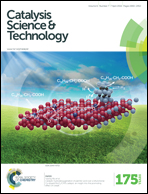Hexaaluminates: a review of the structure, synthesis and catalytic performance
Abstract
Hexaaluminates, a class of hexagonal aluminate compounds, have peculiar layered structures consisting of alternatively stacked spinel blocks of close packed oxide ions and mirror planes. These materials exhibit stable phase composition up to 1600 °C and exceptional resistance to sintering and thermal shock, which make them attractive catalysts for high-temperature applications. In this review, the structure of hexaaluminates is firstly introduced. Then we discuss recent advances in the synthesis and catalytic applications of metal-substituted or supported hexaaluminates such as the catalytic combustion of CH4, partial oxidation and CO2 reforming of CH4 to syngas and decomposition of N2O with a special emphasis on the effect of the chemical state of metals in the hexaaluminate framework on the catalytic performance. Finally, a brief summary and an outlook on some of the scientific challenges and suggestions for future investigations in the field are given.


 Please wait while we load your content...
Please wait while we load your content...